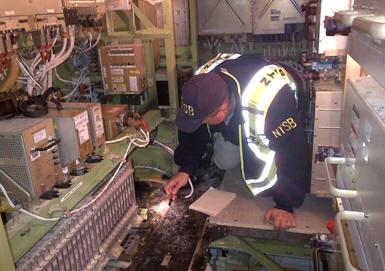 |
|
|
|
|
|
|
|
|
The NTSB learned that as part of the risk assessment
Boeing conducted during the certification process, it
determined that the likelihood of a smoke emission event
from a 787 battery would occur less than once in every
10 million flight hours. Noting that there have been two
critical battery events on the 787 fleet with fewer than
100,000 flight hours, Hersman said that "the failure
rate was higher than predicted as part of the
certification process and the possibility that a short
circuit in a single cell could propagate to adjacent
cells and result in smoke and fire must be
reconsidered."
As
the investigation continues, which will include testing
on some of the batteries that had been replaced after
being in service in the 787 fleet, the NTSB will
continue to share its findings in real time with the
FAA, Boeing, the Japan Transport Safety Board, and the
French investigative agency, the Bureau d'Enquêtes et
d'Analyses.
"The decision to return the fleet to flight will be
made by the FAA, which underscores the importance of
cooperation and coordination between our agencies,"
Hersman said. She also announced that the NTSB would
release an interim report of factual findings within
30 days.
Boeing reports it welcomes the progress reported by the
U.S. National Transportation Safety Board (NTSB) in
the 787 investigation, including that the NTSB has
identified the origin of the event as having been
within the battery. “The findings demonstrated a
narrowing of the focus of the investigation to short
circuiting observed in the battery, while providing
the public with a better understanding of the nature
of the investigation”.
“The 787 was certified following a rigorous Boeing test
program and an extensive certification program
conducted by the FAA. We provided testing and
analysis in support of the requirements of the FAA
special conditions associated with the use of
lithium ion batteries. We are working
collaboratively to address questions about our
testing and compliance with certification standards,
and we will not hesitate to make changes that lead
to improved testing processes and products”.
Secretary LaHood and Administrator Huerta - “DOT is focused
on the safety of the traveling public.
From day one, we have said that the
comprehensive review of the Boeing 787 and the root
cause analysis of the two battery incidents would be
a data-driven process.
Based on what information our experts find,
the FAA will take any action necessary to further
ensure safety.
We must finish this work before reaching
conclusions about what changes or improvements the
FAA should make going forward.
The leading experts in this field are working
to understand what happened and how we can safely
get these aircraft back into service.
“Last month, we announced a comprehensive review of the
787’s critical systems including the aircraft’s
design, manufacture and assembly.
Since then, the FAA's team of technical
experts has been working around the clock to
understand what happened and how best to prevent
these issues from recurring. As part of this effort,
the FAA is looking at both the certification process
and specifically at the required tests and design of
the aircraft’s lithium ion battery.
The FAA invited the NTSB to observe this
FAA-led process.
“The FAA is also lending our technical experts to support
the NTSB's investigation into the probable cause of
the battery incidents.
The agency will also evaluate information
from the investigations of these incidents and will
take action as appropriate.
“As the agency said last month, the FAA is focused on the
review and activities to understand the root cause.
Once the review is complete, the FAA will make any
analysis and conclusions public.”
|
||||
|
|
||||


